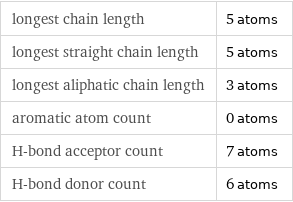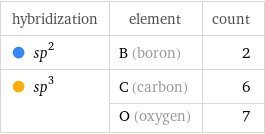Input interpretation

diboronic acid bis(1, 3-propanediol)
Basic properties

molar mass | 225.8 g/mol formula | C_6H_20B_2O_7 empirical formula | C_6O_7B_2H_20 SMILES identifier | C(CO)CO.C(CO)CO.B(O)OBO InChI identifier | InChI=1/2C3H8O2.B2H4O3/c2*4-2-1-3-5;3-1-5-2-4/h2*4-5H, 1-3H2;1-4H InChI key | NXTQVDIIORHJLS-UHFFFAOYSA-N
Structure diagram

Structure diagram
Quantitative molecular descriptors

longest chain length | 5 atoms longest straight chain length | 5 atoms longest aliphatic chain length | 3 atoms aromatic atom count | 0 atoms H-bond acceptor count | 7 atoms H-bond donor count | 6 atoms
Elemental composition

Find the elemental composition for diboronic acid bis(1, 3-propanediol) in terms of the atom and mass percents: atom percent = N_i/N_atoms × 100% mass percent = (N_im_i)/m × 100% Plan: • Write the chemical formula and gather atomic masses from the periodic table. • Determine values for N_i, m_i, N_atoms and m using these items. • Finally, compute the percents and check the results. Write the chemical formula: C_6H_20B_2O_7 Use the chemical formula to count the number of atoms, N_i, for each element and find the total number of atoms, N_atoms, per molecule: | number of atoms C (carbon) | 6 O (oxygen) | 7 B (boron) | 2 H (hydrogen) | 20 N_atoms = 6 + 7 + 2 + 20 = 35 Divide each N_i by N_atoms to calculate atom fractions. Then use the property that atom fractions must sum to one to check the work: | number of atoms | atom fraction C (carbon) | 6 | 6/35 O (oxygen) | 7 | 7/35 B (boron) | 2 | 2/35 H (hydrogen) | 20 | 20/35 Check: 6/35 + 7/35 + 2/35 + 20/35 = 1 Compute atom percents using the atom fractions: | number of atoms | atom percent C (carbon) | 6 | 6/35 × 100% = 17.1% O (oxygen) | 7 | 7/35 × 100% = 20.0% B (boron) | 2 | 2/35 × 100% = 5.71% H (hydrogen) | 20 | 20/35 × 100% = 57.1% Look up the atomic mass, m_i, in unified atomic mass units, u, for each element in the periodic table: | number of atoms | atom percent | atomic mass/u C (carbon) | 6 | 17.1% | 12.011 O (oxygen) | 7 | 20.0% | 15.999 B (boron) | 2 | 5.71% | 10.81 H (hydrogen) | 20 | 57.1% | 1.008 Multiply N_i by m_i to compute the mass for each element. Then sum those values to compute the molecular mass, m: | number of atoms | atom percent | atomic mass/u | mass/u C (carbon) | 6 | 17.1% | 12.011 | 6 × 12.011 = 72.066 O (oxygen) | 7 | 20.0% | 15.999 | 7 × 15.999 = 111.993 B (boron) | 2 | 5.71% | 10.81 | 2 × 10.81 = 21.62 H (hydrogen) | 20 | 57.1% | 1.008 | 20 × 1.008 = 20.160 m = 72.066 u + 111.993 u + 21.62 u + 20.160 u = 225.839 u Divide the mass for each element by m to calculate mass fractions. Then use the property that mass fractions must sum to one to check the work: | number of atoms | atom percent | mass fraction C (carbon) | 6 | 17.1% | 72.066/225.839 O (oxygen) | 7 | 20.0% | 111.993/225.839 B (boron) | 2 | 5.71% | 21.62/225.839 H (hydrogen) | 20 | 57.1% | 20.160/225.839 Check: 72.066/225.839 + 111.993/225.839 + 21.62/225.839 + 20.160/225.839 = 1 Compute mass percents using the mass fractions: Answer: | | | number of atoms | atom percent | mass percent C (carbon) | 6 | 17.1% | 72.066/225.839 × 100% = 31.91% O (oxygen) | 7 | 20.0% | 111.993/225.839 × 100% = 49.59% B (boron) | 2 | 5.71% | 21.62/225.839 × 100% = 9.573% H (hydrogen) | 20 | 57.1% | 20.160/225.839 × 100% = 8.927%
Elemental oxidation states

The first step in finding the oxidation states (or oxidation numbers) in diboronic acid bis(1, 3-propanediol) is to draw the structure diagram. Next set every oxidation number equal to the atom's formal charge: There are 2 boron-hydrogen bonds, 4 boron-oxygen bonds, 12 carbon-hydrogen bonds, 4 carbon-oxygen bonds, 6 oxygen-hydrogen bonds, and 4 carbon-carbon bonds in diboronic acid bis(1, 3-propanediol). For each of these bonds, assign the bonding electrons to the most electronegative element. First examine the boron-hydrogen bonds: element | electronegativity (Pauling scale) | B | 2.04 | H | 2.20 | | | Since hydrogen is more electronegative than boron, the electrons in these bonds will go to hydrogen. Decrease the oxidation number for hydrogen in every highlighted bond (by 1 for single bonds, 2 for double bonds, and 3 for triple bonds), and increase the oxidation number for boron accordingly: Next look at the boron-oxygen bonds: element | electronegativity (Pauling scale) | B | 2.04 | O | 3.44 | | | Since oxygen is more electronegative than boron, the electrons in these bonds will go to oxygen: Next look at the carbon-hydrogen bonds: element | electronegativity (Pauling scale) | C | 2.55 | H | 2.20 | | | Since carbon is more electronegative than hydrogen, the electrons in these bonds will go to carbon: Next look at the carbon-oxygen bonds: element | electronegativity (Pauling scale) | C | 2.55 | O | 3.44 | | | Since oxygen is more electronegative than carbon, the electrons in these bonds will go to oxygen: Next look at the oxygen-hydrogen bonds: element | electronegativity (Pauling scale) | O | 3.44 | H | 2.20 | | | Since oxygen is more electronegative than hydrogen, the electrons in these bonds will go to oxygen: Next look at the carbon-carbon bonds: element | electronegativity (Pauling scale) | C | 2.55 | C | 2.55 | | | Since these elements are the same the bonding electrons are shared equally, and there is no change to the oxidation states: Now summarize the results: Answer: | | oxidation state | element | count -2 | C (carbon) | 2 | O (oxygen) | 7 -1 | C (carbon) | 4 | H (hydrogen) | 2 +1 | H (hydrogen) | 18 +3 | B (boron) | 2
Orbital hybridization

hybridization | element | count sp^2 | B (boron) | 2 sp^3 | C (carbon) | 6 | O (oxygen) | 7
Structure diagram

Orbital hybridization Structure diagram
Topological indices

vertex count | 35 edge count | 32 Schultz index | Wiener index | Hosoya index | Balaban index |